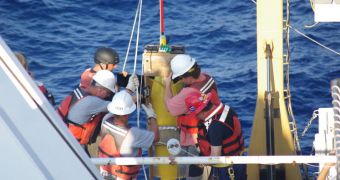Officials at the US National Oceanic and Atmospheric Administration (NOAA) announce that they have dispatched the ship Thomas Jefferson into the Gulf of Mexico. The vessel is to travel at the site of the Deepwater Horizon disaster, and install monitoring and other scientific equipment at the location. This will allow scientists to keep a closer eye on how things are evolving at this location. The oil slick generated by the explosion has been increasing in size for the past five weeks, and NOAA plans to conduct accurate observations of what is happening.
According to the federal agency, the research ship will launch floats, drifters and gliders belonging to the US Navy, which will ensure around-the-clock surveillance of ground zero, the place where it all started. The semi-submersible drilling rig blew up on April 20, some 50 miles away from the Louisiana coastline, and the platform sunk on April 22, killing 11 crew members. Since then, at least 5,000 barrels of crude have been spilling into the waters every single day, and all efforts aimed at preventing further contamination have thus far failed.
What NOAA plans to do now is to keep a close eye on the possible directions the oil slick may head into next. There are numerous oceanic current churning the surface at or near the site of the accident, and the monitoring equipment is destined to assess where the crude is most likely to go. A special deal of attention will be given to monitoring the Loop Current, a deep-water current that leads to the Florida coast and its delicate coral reefs, and then onwards to the Gulf Stream. If the latter is contaminated, then the entire eastern US coast could be devastated, alongside the west coasts of Europe.
“NOAA is proud to partner with the US Navy in the ongoing effort to provide scientific data critical to understanding the Loop Current and the marine environment in the Deepwater Horizon spill area. NOAA Ship Thomas Jefferson’s mission will add significantly to the growing body of information NOAA is gathering on the Gulf of Mexico's dynamic environment in collaboration with our federal agency and university partners,” explains the agency's Administrator, Jane Lubchenco, PhD. She is also the undersecretary of commerce for oceans and atmosphere. In addition to the Thomas Jefferson, NOAA has also been deploying research airplanes in the Gulf, to help monitor the clean-up efforts, and provide even more data on the oil slick.

 14 DAY TRIAL //
14 DAY TRIAL //